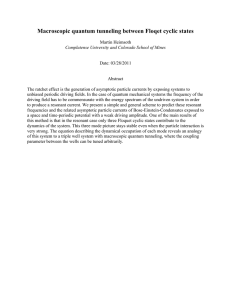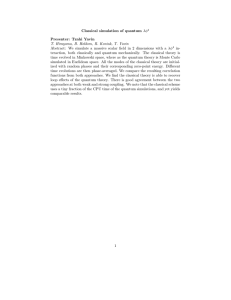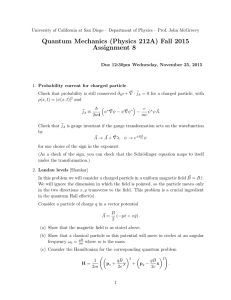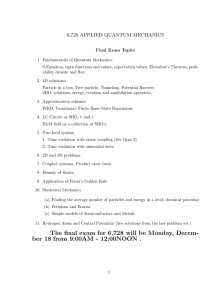1. Generalities on quantum field ... Classical mechanics. q
advertisement
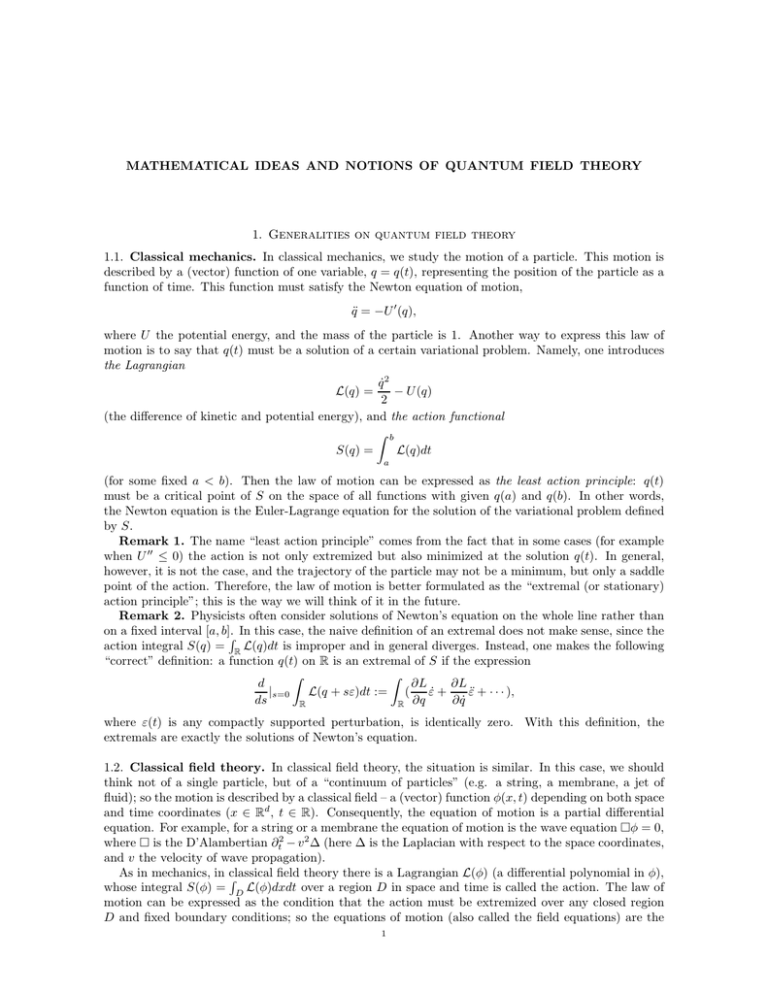
MATHEMATICAL IDEAS AND NOTIONS OF QUANTUM FIELD THEORY 1. Generalities on quantum field theory 1.1. Classical mechanics. In classical mechanics, we study the motion of a particle. This motion is described by a (vector) function of one variable, q = q(t), representing the position of the particle as a function of time. This function must satisfy the Newton equation of motion, q̈ = −U (q), where U the potential energy, and the mass of the particle is 1. Another way to express this law of motion is to say that q(t) must be a solution of a certain variational problem. Namely, one introduces the Lagrangian q̇ 2 − U (q) L(q) = 2 (the difference of kinetic and potential energy), and the action functional � b S(q) = L(q)dt a (for some fixed a < b). Then the law of motion can be expressed as the least action principle: q(t) must be a critical point of S on the space of all functions with given q(a) and q(b). In other words, the Newton equation is the Euler-Lagrange equation for the solution of the variational problem defined by S. Remark 1. The name “least action principle” comes from the fact that in some cases (for example when U ≤ 0) the action is not only extremized but also minimized at the solution q(t). In general, however, it is not the case, and the trajectory of the particle may not be a minimum, but only a saddle point of the action. Therefore, the law of motion is better formulated as the “extremal (or stationary) action principle”; this is the way we will think of it in the future. Remark 2. Physicists often consider solutions of Newton’s equation on the whole line rather than on a fixed interval [a, b].� In this case, the naive definition of an extremal does not make sense, since the action integral S(q) = R L(q)dt is improper and in general diverges. Instead, one makes the following “correct” definition: a function q(t) on R is an extremal of S if the expression � � d ∂L ∂L |s=0 ε̇ + ε̈ + · · · ), L(q + sε)dt := ( ds ∂q̇ R R ∂q where ε(t) is any compactly supported perturbation, is identically zero. With this definition, the extremals are exactly the solutions of Newton’s equation. 1.2. Classical field theory. In classical field theory, the situation is similar. In this case, we should think not of a single particle, but of a “continuum of particles” (e.g. a string, a membrane, a jet of fluid); so the motion is described by a classical field – a (vector) function φ(x, t) depending on both space and time coordinates (x ∈ Rd , t ∈ R). Consequently, the equation of motion is a partial differential equation. For example, for a string or a membrane the equation of motion is the wave equation �φ = 0, where � is the D’Alambertian ∂t2 − v 2 ∆ (here ∆ is the Laplacian with respect to the space coordinates, and v the velocity of wave propagation). As in mechanics, in classical field theory there is a Lagrangian L(φ) (a differential polynomial in φ), � whose integral S(φ) = D L(φ)dxdt over a region D in space and time is called the action. The law of motion can be expressed as the condition that the action must be extremized over any closed region D and fixed boundary conditions; so the equations of motion (also called the field equations) are the 1 2 MATHEMATICAL IDEAS AND NOTIONS OF QUANTUM FIELD THEORY Euler-Lagrange equations for this variational problem. For example, in the case of string or membrane, the Lagrangian is 1 L(u) = (φ2t − v 2 (∇φ)2 ). 2 Remark. Like in mechanics, solutions of the field equations on the whole space (rather than a closed region D) are extremals of the action in the sense that � d |s=0 L(u + sε)dxdt = 0, ds Rd+1 where ε is a compactly supported perturbation. 1.3. Brownian motion. One of the main differences between classical and quantum mechanics is, roughly speaking, that quantum particles do not have to obey the classical equations of motion, but can randomly deviate from their classical trajectories. Therefore, given the position and velocity of the particle at a given time, we cannot determine its position at a later time, but can only determine the density of probability that at this later time the particle will be found at a given point. In this sense quantum particles are similar to random (Brownian) particles. Brownian particles are a bit easier to understand conceptually, so let us begin with them. The motion of a Brownian particle in Rd in a potential field U : Rd → R is described by a stochastic process q = q(t), q = (q1 , . . . , qd ) ∈ Rd . That is, for each real t we have a random variable q(t) (position of the particle at a time t), such that the dependence of t is regular in some sense. The random dynamics of the particle is “defined” as follows: 1 if y : [a, b] → Rd is a continuously differentiable function, then the density of probability that q(t) = y(t) for t ∈ [a, b] is proportional to e−S(y)/κ , where �b 2 S(y) := a ( 12 y − U (y))dt is the action for the corresponding classical mechanical system, and κ is the diffusion coefficient. Thus, for given q(a) and q(b), the likeliest q(t) is the one that minimizes S (in particular, solves the classical equations of motion q̈ = −U (q)), while the likelihood of the other paths decays exponentially with the deviation of the action of these paths from the minimal possible. Remark. This discussion assumes that the extremum of S at q is actually a minimum, which we know is not always the case. All the information we can hope to get about such a process is contained in the correlation functions < qi1 (t1 ) . . . qin (tn ) >, which by definition are the expectation values of the products of random variables qi1 (t1 ) . . . qin (tn ) (more specifically, by Kolmogorov’s theorem the stochastic process q(t) is completely determined by these functions). So such functions should be regarded as the output, or answer, of the theory of the Brownian particle. So the main question is how to compute the correlation functions. The definition above obviously gives the following answer: given t1 , . . . , tn ∈ [a, b], we have � (1) < qj1 (t1 ) . . . qjn (tn ) >= qj1 (t1 ) . . . qjn (tn )e−S(q)/κ Dq, where integration is carried out over the space of paths [a, b] → Rn , and Dq is a Lebesgue measure on � −S(q)/κ the space of paths such that e Dq = 1. Such an integral is called a path integral, since it is an integral over the space of paths. It is clear, however, that such definition and answer are a priori not satisfactory from the mathematical viewpoint, since the infinite dimensional integration that we used requires justification. In this particular case, such justification is possible within the framework of Lebesgue measure theory, and the corresponding integration theory is called the theory of Wiener integrals. (To be more precise, one cannot define the measure Dq, but one can define the measure e−S(q)/κ Dq for sufficiently nice potentials U (q)). 1We put the word “defined” in quotation marks because this definition is obviously heuristic and not rigorous; see below for more explanations MATHEMATICAL IDEAS AND NOTIONS OF QUANTUM FIELD THEORY 3 1.4. Quantum mechanics. Now let us turn to a quantum particle. Quantum mechanics is notoriously difficult to visualize, and the randomness of the behavior of a quantum particle is less intuitive and more subtle than that of a Brownian particle; nevertheless, it was pointed out by Feynman that the behavior of a quantum particle in a potential field U (q) is correctly described by the same model, with the real positive parameter κ replaced by the imaginary number i, where > 0 is the Planck constant. In other words, the dynamics of a quantum particle can be expressed (we will discuss later how) via the correlation functions � (2) < qj1 (t1 ) . . . qjn (tn ) >= qj1 (t1 ) . . . qjn (tn )eiS(q)/ Dq, � where Dq is normalized so that eiS(q)/ Dq = 1. 1.5. Quantum field theory. The situation is the same in field theory. Namely, a useful theory of quantum fields (used in the study of interactions of elementary particles) is obtained when one considers correlation functions � (3) < φj1 (x1 , t1 ) . . . φjn (xn , tn ) >= φj1 (x1 , t1 ) . . . φjn (xn , tn )eiS(φ)/ Dφ, � where Dφ is normalized so that eiS(φ)/ Dφ = 1. Of course, from the mathematical point of view, this setting is a priori even less satisfactory than the one for the Brownian particle, since it involves integration with respect to the complex valued measure eiS(q)/ Dq, which nobody knows how to define. Nevertheless, physicists imagine that certain integrals of this type exist and come to correct and interesting conclusions (both physical and mathematical). Therefore, making sense of such integrals is an interesting problem for mathematicians, and will be one of our main occupation during the course.2 2to be more precise, we will make sense of path integrals as power series in κ or .


